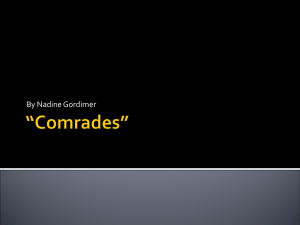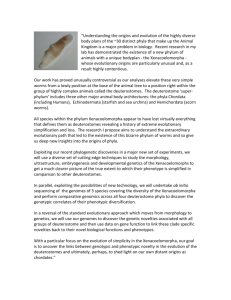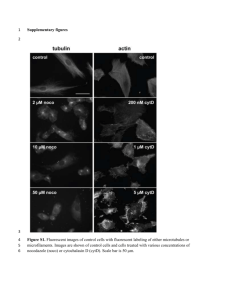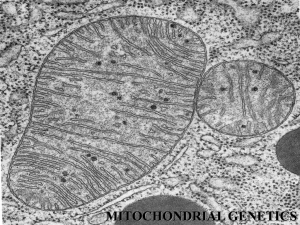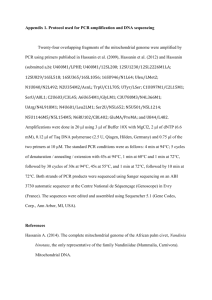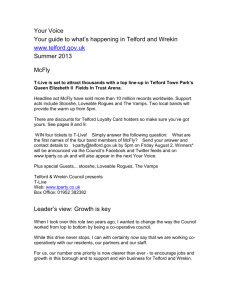Research Projects
advertisement
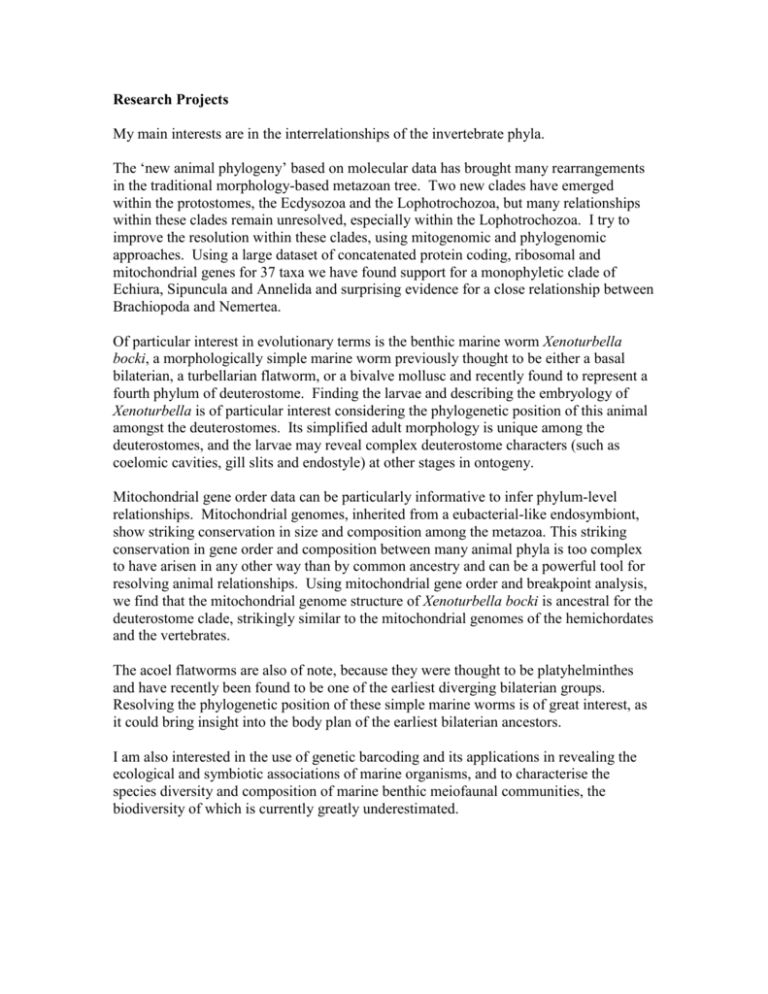
Research Projects My main interests are in the interrelationships of the invertebrate phyla. The ‘new animal phylogeny’ based on molecular data has brought many rearrangements in the traditional morphology-based metazoan tree. Two new clades have emerged within the protostomes, the Ecdysozoa and the Lophotrochozoa, but many relationships within these clades remain unresolved, especially within the Lophotrochozoa. I try to improve the resolution within these clades, using mitogenomic and phylogenomic approaches. Using a large dataset of concatenated protein coding, ribosomal and mitochondrial genes for 37 taxa we have found support for a monophyletic clade of Echiura, Sipuncula and Annelida and surprising evidence for a close relationship between Brachiopoda and Nemertea. Of particular interest in evolutionary terms is the benthic marine worm Xenoturbella bocki, a morphologically simple marine worm previously thought to be either a basal bilaterian, a turbellarian flatworm, or a bivalve mollusc and recently found to represent a fourth phylum of deuterostome. Finding the larvae and describing the embryology of Xenoturbella is of particular interest considering the phylogenetic position of this animal amongst the deuterostomes. Its simplified adult morphology is unique among the deuterostomes, and the larvae may reveal complex deuterostome characters (such as coelomic cavities, gill slits and endostyle) at other stages in ontogeny. Mitochondrial gene order data can be particularly informative to infer phylum-level relationships. Mitochondrial genomes, inherited from a eubacterial-like endosymbiont, show striking conservation in size and composition among the metazoa. This striking conservation in gene order and composition between many animal phyla is too complex to have arisen in any other way than by common ancestry and can be a powerful tool for resolving animal relationships. Using mitochondrial gene order and breakpoint analysis, we find that the mitochondrial genome structure of Xenoturbella bocki is ancestral for the deuterostome clade, strikingly similar to the mitochondrial genomes of the hemichordates and the vertebrates. The acoel flatworms are also of note, because they were thought to be platyhelminthes and have recently been found to be one of the earliest diverging bilaterian groups. Resolving the phylogenetic position of these simple marine worms is of great interest, as it could bring insight into the body plan of the earliest bilaterian ancestors. I am also interested in the use of genetic barcoding and its applications in revealing the ecological and symbiotic associations of marine organisms, and to characterise the species diversity and composition of marine benthic meiofaunal communities, the biodiversity of which is currently greatly underestimated. Publications Bourlat, S.J., Rota-Sabelli, O., Lanfear, R. and Telford, MJ. The mitochondrial genome of Xenoturbella bocki (phylum Xenoturbellida) and the ancestral deuterostome mitochondrial gene order. Submitted. Bourlat, S.J., Nielsen C., Economou A.E., Telford MJ (2008). Refining the new animal phylogeny: A phylum level molecular analysis of the animal kingdom. Molecular Phylogenetics and Evolution. In review. Telford, M.J., Bourlat, S.J., Economou, E., Papillon, D., Rota-Stabelli, O. (2008) The Evolution of the Ecdysozoa. Phil. Trans. R. Soc. B. 363(1496):1529-37. Bourlat, S.J., Nakano, H., Ackerman, M., Telford, M.J., Thorndyke, M.C., Obst, M, (2008). Feeding ecology of Xenoturbella bocki (phylum Xenoturbellida) revealed by genetic barcoding. Molecular Ecology Resources. 8(1): 18-22. Bourlat, S.J., Juliusdottir T, Lowe CJ, Freeman R, Aronowicz J, Kirschner M, Lander ES, Thorndyke M, Nakano H, Kohn AB, Heyland A, Moroz LL, Copley RR, Telford MJ (2006). Deuterostome phylogeny reveals monophyletic chordates and the new phylum Xenoturbellida. Nature. 444(7115): 85-88. Webster, B. L., Copley, R.R., Jenner, R.A., Mackenzie-Dodds J.A., Bourlat, S.J., RotaStabelli, O., Littlewood, D.T.J., and Telford, M.J, (2006). Mitogenomics and Phylogenomics Reveal Priapulid Worms as Extant Models of the Ancestral Ecdysozoan. Evol. Dev. 8 (6):502-10. Bourlat S.J. Xenoturbella (Invertebrate Systematics) 2005. McGraw-Hill Yearbook of Science and Technology. Bourlat S.J. Xenoturbella (Invertebrate Systematics) 2004. McGraw-Hill Encyclopedia of Science and Technology. Bourlat, S.J., Nielsen C, Lockyer AE, Littlewood DT, Telford MJ. (2003). Xenoturbella is a deuterostome that eats molluscs. Nature. 424(6951): 925-8. Gartner A., Jovanovic A., Jeoung D., Bourlat S., Cross F.R. and Ammerer G., (1998). Pheromone-dependant G1 cell cycle arrest requires Far1 phosphorylation, but may not involve inhibition of Cdc28-Cln2 kinase, in vivo. Mol. Cell. Biol. 18: 3681-3691.


